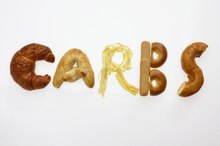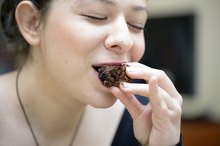What does fact checked mean?
At Healthfully, we strive to deliver objective content that is accurate and up-to-date. Our team periodically reviews articles in order to ensure content quality. The sources cited below consist of evidence from peer-reviewed journals, prominent medical organizations, academic associations, and government data.
- Biochemistry. 5th Edition: Berg JM, Tymoczko JL, Stryer L.
- Biochemistry. 5th Edition: Berg JM, Tymoczko JL, Stryer L.
- Journal of Clinical Endocrinology & Metabolism: Plasma ghrelin Levels in Lean and Obese Humans and the Effect of Glucose on Ghrelin Secretion
- Journal of Clinical Endocrinology & Metabolism: Plasma ghrelin Levels in Lean and Obese Humans and the Effect of Glucose on Ghrelin Secretion
The information contained on this site is for informational purposes only, and should not be used as a substitute for the advice of a professional health care provider. Please check with the appropriate physician regarding health questions and concerns. Although we strive to deliver accurate and up-to-date information, no guarantee to that effect is made.
Differences Between Fasting and Starving
Both starvation and fasting are states of abstinence from food. The main differences between the two are the purpose and length of time of that abstinence. In both cases, the physiological changes that take place help the body adapt to the nutrient deficit. While fasting is generally a safe practice, it can be harmful if prolonged.
The Body's Sources of Fuel
When you eat, your body breaks down the food into sugars, fatty acids and amino acids. These are the basic building blocks needed for maintaining bodily processes. Sugar, or glucose, is stored in the liver and muscles in a chemical form called glycogen. Fat is stored as fatty acids in adipose tissue, otherwise known as "fat cells." Amino acids make up the protein that builds muscle. When you no longer consume these important nutrients, your body must metabolize muscle protein, glycogen and stored fat to meet your nutritional needs.
- When you eat, your body breaks down the food into sugars, fatty acids and amino acids.
Fasting Versus Starving
The Glucose Free Diet
Learn More
In the absence of food intake, hormonal changes take place that allow the body to make use of those stored nutrients. For example, insulin, epinephrine and glucagon are hormones that work together to regulate blood sugar. Insulin brings down blood sugar levels by causing cells to take up glucose, while epinephrine and glucagon elevate blood sugar by controlling the breakdown of glycogen. During starvation, insulin decreases and glucagon and epinephrine increase. This is often when you feel hungry. The interplay between these hormones allows the body to keep blood sugar levels stable during a fast. In starvation, however, glycogen has been used up and molecules called ketones are generated from stored fatty acids to be used as an alternative fuel. In addition, protein from muscle can be used to make glucose, which is when food avoidance becomes dangerous. When the body begins breaking down its own muscle for protein, distortion of cells and even death from organ failure may occur.
- In the absence of food intake, hormonal changes take place that allow the body to make use of those stored nutrients.
- The interplay between these hormones allows the body to keep blood sugar levels stable during a fast.
Reasons for Food Abstinence
Starvation and fasting have different purposes. Starvation can be the result of an eating disorder or an undesired consequence of lack of access to food. Alternatively, fasting is typically performed for a defined period of time for a particular purpose, such as a religious practice, in preparation for a medical procedure or as part of a cleanse. Fasting may include a very low-calorie diet, which has been attempted as a health-promoting practice. A small study at Washington University School of Medicine published in the "Proceedings of the National Academy of the Sciences" in 2003 suggested that caloric restriction reduced cardiovascular disease risk 3.
- Starvation and fasting have different purposes.
- Fasting may include a very low-calorie diet, which has been attempted as a health-promoting practice.
Safety First
Dopamine & Appetite
Learn More
When embarking on a fast, it is important to proceed with caution to avoid starvation. Side effects may include headaches, dizziness and low blood pressure. The American Cancer Society claims that fasting for a short period of time, such as eight to 12 hours, is not likely to be harmful, provided that fluid intake is adequate 6.
Related Articles
References
- Biochemistry. 5th Edition: Berg JM, Tymoczko JL, Stryer L.
- Cell Death and Differentiation: Autophagy: molecular machinery for self-eating
- Proceedings of the National Academy of the Sciences: Long-term calorie restriction is highly effective in reducing the risk for atherosclerosis in humans
- NBC News: Some Try Extreme Calorie $estriction for Long Life
- Journal of Clinical Endocrinology & Metabolism: Plasma ghrelin Levels in Lean and Obese Humans and the Effect of Glucose on Ghrelin Secretion
- American Cancer Society: Fasting
- National Institute of Diabetes and Digestive and Kidney Diseases. Insulin resistance and prediabetes. Updated May 2018.
- American Diabetes Association. 2. Classification and Diagnosis of Diabetes: Standards of Medical Care in Diabetes-2020. Diabetes Care. 2020;43(Suppl 1):S14-S31. doi:10.2337/dc20-S002
- Tello, M. Intermittent fasting: Surprising update. Harvard Health Publishing. Harvard Medical School. Updated June 29, 2018.
- Diabetes.co.uk. 5:2 tasting diet. Updated January 15, 2019
- De cabo R, Mattson MP. Effects of intermittent fasting on health, aging, and disease. N Engl J Med. 2019;381(26):2541-2551. doi:10.1056/NEJMra1905136
- Grajower MM, Horne BD. Clinical management of intermittent fasting in patients with diabetes mellitus. Nutrients. 2019;11(4). doi:10.3390/nu11040873
- Diabetes UK. Fasting and diabetes.
- Carter S, Clifton PM, Keogh JB. Effect of intermittent compared with continuous energy restricted diet on glycemic control in patients with type 2 diabetes: A randomized noninferiority trial. JAMA Netw Open. 2018;1(3):e180756. doi:10.1001/jamanetworkopen.2018.0756
- Eckel-mahan K, Sassone-corsi P. Metabolism and the circadian clock converge. Physiol Rev. 2013;93(1):107-35. doi:10.1152/physrev.00016.2012
- Ravussin E, Beyl RA, Poggiogalle E, Hsia DS, Peterson CM. Early Time-Restricted Feeding Reduces Appetite and Increases Fat Oxidation But Does Not Affect Energy Expenditure in Humans. Obesity (Silver Spring). 2019;27(8):1244-1254. doi:10.1002/oby.22518
- Sutton EF, Beyl R, Early KS, Cefalu WT, Ravussin E, Peterson CM. Early time-restricted feeding improves insulin sensitivity, blood pressure, and oxidative stress even without weight loss in men with prediabetes. Cell Metab. 2018;27(6):1212-1221.e3. doi:10.1016/j.cmet.2018.04.010
Writer Bio
Gina Riggio is a research technician in a molecular genomics laboratory at a large research university. She is also a registered dietetic technician with a background in long-term care and special dietary needs. Riggio earned a bachelor's degree in nutritional sciences from Penn State University.









